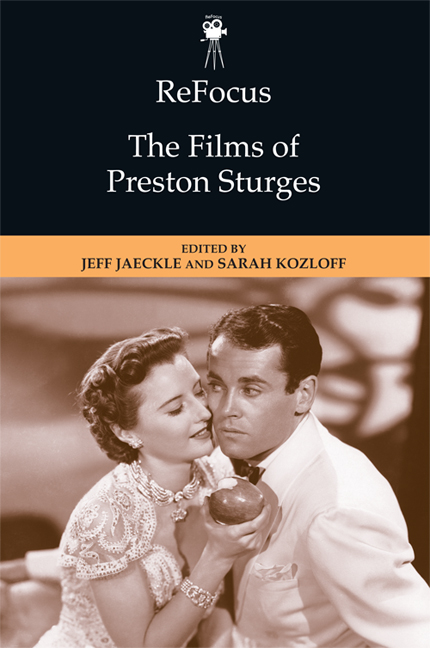Book contents
- Frontmatter
- Contents
- List of Figures
- Notes on Contributors
- Introduction: An Agile Mind—The Many Stands of Preston Sturges
- Part 1 Contexts: Genre, Studio, Authorship
- Part 2 Cultural Commentary: History and Identity
- 5 Sturges's Many Mothers
- 6 “These Are Troublous Times”: Social Class in the Comedies of Preston Sturges
- 7 “They Always Get the Best of You Somehow”: Preston Sturges in Black and White
- 8 Falling Hard: The Sin of Harold Diddlebock
- Part 3 Technique: Scripting, Performance, Music
- Part 4 Impact: Reception/Reputation
- Index
7 - “They Always Get the Best of You Somehow”: Preston Sturges in Black and White
from Part 2 - Cultural Commentary: History and Identity
Published online by Cambridge University Press: 05 September 2016
- Frontmatter
- Contents
- List of Figures
- Notes on Contributors
- Introduction: An Agile Mind—The Many Stands of Preston Sturges
- Part 1 Contexts: Genre, Studio, Authorship
- Part 2 Cultural Commentary: History and Identity
- 5 Sturges's Many Mothers
- 6 “These Are Troublous Times”: Social Class in the Comedies of Preston Sturges
- 7 “They Always Get the Best of You Somehow”: Preston Sturges in Black and White
- 8 Falling Hard: The Sin of Harold Diddlebock
- Part 3 Technique: Scripting, Performance, Music
- Part 4 Impact: Reception/Reputation
- Index
Summary
I am often surprised when friends in the jazz studies world turn out to be as devoted to movies as they are to the music. One night about twenty years ago, a jazz writer and I were sitting in a club between sets when I discovered that we both had a passion for Preston Sturges. He soon asked, however, “Have you ever noticed how every Sturges film has a scene with a demeaning stereotype of a black person?” I immediately thought of what may be the single most memorable moment in the entire Sturges canon, the drunken rampage by the Ale and Quail Club in The Palm Beach Story that begins with two of the members blasting away with shotguns while a terrified black bartender throws soda crackers into the air. The English journalist John Pym lists the bartender first when he writes about “the coloured characters” in The Palm Beach Story who make up the one “discordant and profoundly unappealing note” in a film he otherwise finds to be nearly flawless.
To make matters even more “unappealing,” Fred Toones, the actor playing the bartender, is identified in the end credits only as “Snowflake.” Although Paramount probably chose to identify Toones in this way, the actor came up with the nickname, just as Lincoln Perry called himself “Stepin Fetchit,” and Willie Best often billed himself as “Sleep and Eat.” Nick Stewart may have been a bit more self-aggrandizing when he called himself “Nicodemus.” Nevertheless, the dehumanizing name Snowflake reinforces the image of the childlike, timorous, desperate-to-please servant in The Palm Beach Story. But is this scene really typical of Sturges? And even if this scene were an anomaly—which it is not—how do we adjust our evaluation and appreciation of Sturges as a filmmaker?
When I was asked to contribute an essay on Sturges and race to this collection, I again thought of the terrified black bartender ducking behind the bar and looking even more ridiculous when he emerges wearing an ice bucket on his head for protection. But I quickly learned that my jazz writer friend was wrong when he said that all of Sturges's films are insulting to black people.
- Type
- Chapter
- Information
- ReFocus: The Films of Preston Sturges , pp. 155 - 172Publisher: Edinburgh University PressPrint publication year: 2015

